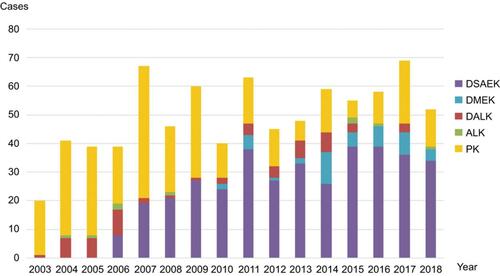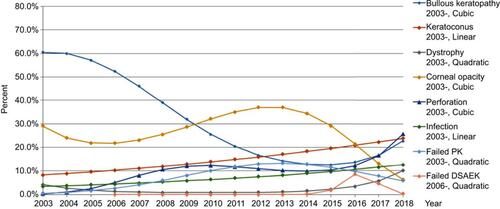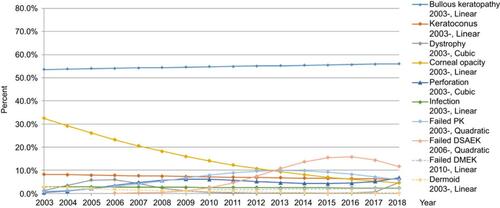Figures & data
Table 1 Total number of keratoplasty procedures from 2003 to 2018
Figure 1 Number of keratoplasty procedures by year. The total annual number of keratoplasty procedures increased from 20 in 2003 to 52 in 2018. PK and DSAEK have consistently remained as major keratoplasty types.
Abbreviations: DSAEK, Descemet’s stripping automated endothelial keratoplasty; DMEK, Descemet’s membrane endothelial keratoplasty; DALK, deep anterior lamellar keratoplasty; ALK, anterior lamellar keratoplasty; PK, penetrating keratoplasty.

Figure 2 Trends in keratoplasty procedures from 2003 to 2018. The incidence of PK procedures decreased, while the incidence of DSAEK significantly increased.
Abbreviations: DSAEK, Descemet’s stripping automated endothelial keratoplasty; DMEK, Descemet’s membrane endothelial keratoplasty; DALK, deep anterior lamellar keratoplasty; ALK, anterior lamellar keratoplasty; PK, penetrating keratoplasty.

Table 2 Underlying disease indications for PK from 2003 to 2018
Figure 3 Trends in underlying diseases for PK from 2003 to 2018. The incidence of BK significantly decreased.
Abbreviations: BK, bullous kerstopathy; DSAEK, Descemet’s stripping automated endothelial keratoplasty; PK, penetrating keratoplasty.

Figure 4 Trends in underlying diseases for all keratoplasty procedures from 2003 to 2018. Corneal opacity and dermoid were decreasing linearly. Failed PK and failed DSAEK were increasing linearly in the beginning of the study period, but in the latter half, reached a plateau.
Abbreviations: DSAEK, Descemet’s stripping automated endothelial keratoplasty; DMEK, Descemet’s membrane endothelial keratoplasty; PK, penetrating keratoplasty.

Table 3 Underlying disease indications for all keratoplasty procedures from 2003 to 2018
Table S1 Trends in total keratoplasty procedures from 2003 to 2018 using logistic regression model analysis and Cochran-Armitage test
Table S2 Changes in the underlying diseases of PK over a 16-year period (2003 to 2018) using logistic regression model analysis and Cochran–Armitage test
Table S3 Changes in the underlying diseases for total keratoplasty from 2003 to 2018 using logistic regression model analysis and Cochran–Armitage test
